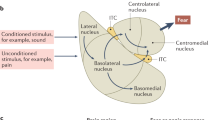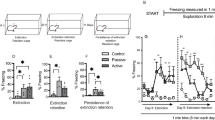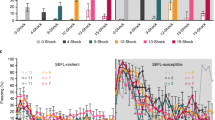Abstract
Post-traumatic stress disorder (PTSD) affects about 20–30% of exposed individuals. Clinical studies of PTSD generally employ stringent criteria for inclusion in study populations, and yet in animal studies the data collection and analysis are generally expressed as a function of exposed vs nonexposed populations, regardless of individual variation in response. Prior data support an approach to animal models analogous to inclusion criteria in clinical studies. This series of studies sought to assess prevalence rates of maladaptive vs adaptive responses determined according to a more stringent approach to the concept of inclusion/exclusion criteria (cutoff behavioral criteria—CBC), consisting of two successive behavioral tests (elevated plus maze and acoustic startle response tests). The rats were exposed to stressors in two different paradigms; exposure to a predator and underwater trauma. The prevalence rates of maladaptive responses to stress in these two distinct models dropped over time from 90% in the acute phase to 25% enduring/maladaptive response at 7 days, to remain constant over 30 days. As setting the affected individuals apart from the unaffected approximates clinical studies, it might also help to clarify some of the pending issues in PTSD research.
Similar content being viewed by others
Log in or create a free account to read this content
Gain free access to this article, as well as selected content from this journal and more on nature.com
or
References
Adamec R (1997). Transmitter systems involved in neural plasticity underlying increased anxiety and defense—implications for understanding anxiety following traumatic stress. Neurosci Biobehav Rev 21: 755–765.
Adamec R, Kent P, Anisman H, Shallow T, Merali Z (1998). Neural plasticity, neuropeptides and anxiety in animals—implications for understanding and treating affective disorder following traumatic stress in humans. Neurosci Biobehav Rev 23: 301–318.
Adamec RE, Burton P, Shallow T, Budgell J (1999). NMDA receptors mediate lasting increases in anxiety-like behavior produced by the stress of predator exposure—implications for anxiety associated with posttraumatic stress disorder. Physiol Behav 65: 723–737.
Adamec RE, Shallow T (1993). Lasting effects on rodent anxiety of a single exposure to a cat. Physiol Behav 54: 101–109.
Adamec RE, Shallow T, Budgell J (1997). Blockade of CCK(B) but not CCK(A) receptors before and after the stress of predator exposure prevents lasting increases in anxiety-like behavior: implications for anxiety associated with posttraumatic stress disorder. Behav Neurosci 111: 435–449.
American Psychiatric Association (1994). Diagnostic and Statistical Manual of Mental Disorders, 4th edn. American Psychiatric Association: Washington, DC.
Blanchard RJ, Blanchard DC, Rodgers J, Weiss SM (1990). The characterization and modelling of antipredator defensive behavior. Neurosci Biobehav Rev 14: 463–472.
Blanchard RJ, Blanchard DC, Weiss SM, Meyer S (1990b). The effects of ethanol and diazepam on reactions to predatory odors. Pharmacol Biochem Behav 35: 775–780.
Blanchard RJ, Nikulina JN, Sakai RR, McKittrick C, McEwen B, Blanchard DC (1998). Behavioral and endocrine change following chronic predatory stress. Physiol Behav 63: 561–569.
Blanchard RJ, Shepherd JK, Rodgers RJ, Magee L, Blanchard DC (1993). Attenuation of antipredator defensive behavior in rats following chronic treatment with imipramine. Psychopharmacology 110: 245–253.
Breslau N, Davis GC, Andreski P, Peterson E (1991). Traumatic events and posttraumatic stress disorder in an urban population of young adults. Arch Gen Psychiatry 48: 216–222.
Breslau N, Kessler RC, Chilcoat HD, Schultz LR, Davis GC, Andreski P (1998). Trauma and posttraumatic stress disorder in the community: the 1996 Detroit Area Survey of Trauma. Arch Gen Psychiatry 55: 626–632.
Cohen H, Benjamin J, Kaplan Z, Kotler M (2000). Administration of high-dose ketoconazole, an inhibitor of steroid synthesis, prevents posttraumatic anxiety in an animal model. Eur Neuropsychopharmacol 10: 429–435.
Cohen H, Friedberg S, Michael M, Kotler M, Zeev K (1996). Interaction of CCK-4 induced anxiety and post-cat exposure anxiety in rats. Depress Anxiety 4: 144–145.
Cohen H, Joseph Z, Matar M (2003). The relevance of differential response to trauma in an animal model of post-traumatic stress disorder. Biol Psychiatry 15: 463–473.
Cohen H, Kaplan Z, Kotler M (1999). CCK-antagonists in a rat exposed to acute stress: implication for anxiety associated with post-traumatic stress disorder. Depress Anxiety 10: 8–17.
Fairbank JA, Ebert L, Costello EJ (2000). Epidemiology of traumatic events and post-traumatic stress disorder. In: Nutt D, Davidson JRT, Zohar J (eds). Post Traumatic Stress Disorder: Diagnosis, Management and Treatment. Martin Dunitz Ltd: London. pp 17–27.
File SE (1993). The interplay of learning and anxiety in the elevated plus-maze. Behav Brain Res 58: 199–202.
Griebel G, Blanchard DC, Agnes RS, Blanchard RJ (1995a). Differential modulation of antipredator defensive behavior in Swiss-Webster mice following acute or chronic administration of imipramine and fluoxetine. Psychopharmacology (Berl) 120: 57–66.
Griebel G, Blanchard DC, Jung A, Lee JC, Masuda CK, Blanchard RJ (1995b). Further evidence that the mouse defense test battery is useful for screening anxiolytic and panicolytic drugs: effects of acute and chronic treatment with alprazolam. Neuropharmacology 34: 1625–1633.
Helzer JE, Robins LN, McEvoy L (1987). Post-traumatic stress disorder in the general population. Findings of the epidemiologic catchment area survey. N Engl J Med 317: 1630–1634.
Kessler RC, Sonnega A, Bromet E, Hughes M, Nelson CB (1995). Posttraumatic stress disorder in the National Comorbidity Survey. Arch Gen Psychiatry 52: 1048–1060.
Perkonigg A, Kessler RC, Storz S, Wittchen HU (2000). Traumatic events and post-traumatic stress disorder in the community: prevalence, risk factors and comorbidity. Acta Psychiatr Scand 101: 46–59.
Pynoos RS, Ritzmann RF, Steinberg AM, Goenjian A, Prisecaru I (1996). A behavioral animal model of posttraumatic stress disorder featuring repeated exposure to situational reminders. Biol Psychiatry 39: 129–134.
Resnick HS, Kilpatrick DG, Dansky BS, Saunders BE, Best CL (1993). Prevalence of civilian trauma and posttraumatic stress disorder in a representative national sample of women. J Consult Clin Psychol 61: 984–991.
Richter-Levin G (1998). Acute and long-term behavioral correlates of underwater trauma—potential relevance to stress and post-stress syndromes. Psychiatry Res 79: 73–83.
Rodgers RJ, Blanchard DC, Wong LK, Blanchard RJ (1990). Effects of scopolamine on antipredator defense reactions in wild and laboratory rats. Pharmacol Biochem Behav 36: 575–583.
Ruscio AM, Ruscio J, Keane TM (2002). The latent structure of posttraumatic stress disorder: a taxometric investigation of reactions to extreme stress. J Abnorm Psychol 111: 290–301.
Servatius RJ, Ottenweller JE, Natelson BH (1995). Delayed startle sensitization distinguishes rats exposed to one or three stress sessions: further evidence toward an animal model of PTSD. Biol Psychiatry 38: 539–546.
Shalev AY (2000). Post-traumatic stress disorder: diagnosis, history and life course. In: Nutt D, Davidson JRT, Zohar J (eds). Post-traumatic Stress Disorder: Diagnosis, Management and Treatment. Martin Dunitz Ltd: London. pp 1–15.
Shepherd JK, Flores T, Rodgers RJ, Blanchard RJ, Blanchard DC (1992). The anxiety/defense test battery: influence of gender and ritanserin treatment on antipredator defensive behavior. Physiol Behav 51: 277–285.
Shore JH, Vollmer WM, Tatum EL (1989). Community patterns of posttraumatic stress disorders. J Nerv Ment Dis 177: 681–685.
Stam R, Bruijnzeel AW, Wiegant VM (2000). Long-lasting stress sensitisation. Eur J Pharmacol 405: 217–224.
Wang J, Akirav I, Richter-Levin G (2000). Short-term behavioral and electrophysiological consequences of underwater trauma. Physiol Behav 70: 327–332.
Yehuda R, McFarlane AC (1995). Conflict between current knowledge about posttraumatic stress disorder and its original conceptual basis. Am J Psychiatry 152: 1705–1713.
Yehuda R, McFarlane AC, Shalev AY (1998). Predicting the development of posttraumatic stress disorder from the acute response to a traumatic event. Biol Psychiatry 44: 1305–1313.
Acknowledgements
This study was supported by Grant 52/2000 from the Israel Foundation Trusties to GR-L and in part by a grant from NARSAD foundation to HC.
Author information
Authors and Affiliations
Corresponding author
Rights and permissions
About this article
Cite this article
Cohen, H., Zohar, J., Matar, M. et al. Setting Apart the Affected: The Use of Behavioral Criteria in Animal Models of Post Traumatic Stress Disorder. Neuropsychopharmacol 29, 1962–1970 (2004). https://doi.org/10.1038/sj.npp.1300523
Received:
Revised:
Accepted:
Published:
Issue date:
DOI: https://doi.org/10.1038/sj.npp.1300523
Keywords
This article is cited by
-
MDMA treatment paired with a trauma-cue promotes adaptive stress responses in a translational model of PTSD in rats
Translational Psychiatry (2022)
-
Sex-specific roles of hippocampal microRNAs in stress vulnerability and resilience
Translational Psychiatry (2022)
-
Post-Traumatic Stress Disorder: Theoretical Approaches and Animal Models
Neuroscience and Behavioral Physiology (2022)
-
Title: “Labels Matter: Is it stress or is it Trauma?”
Translational Psychiatry (2021)
-
Increased mGlu5 mRNA expression in BLA glutamate neurons facilitates resilience to the long-term effects of a single predator scent stress exposure
Brain Structure and Function (2021)



